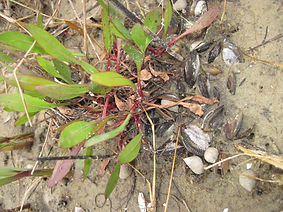
How do abiotic and biotic factors affect the outcomes of species interactions?
Investigating how species interactions are both shaped by abiotic conditions and mediate the response to such conditions can lead to a more mechanistic understanding of interactions and their outcomes. Further, many human caused physical and biological changes occurring in coastal ecosystems can progress rapidly and have significant consequences. For example, physical stress is expected to intensify in many intertidal ecosystems as climate change progresses. The amelioration of stressful environmental conditions can depend on the characteristics of species and individuals interacting. Understanding how such abiotic changes and biotic traits can influence ecological communities is of increasing importance.
Plant-fungal symbiosis responds to experimentally increased resource availability and physical stress
Plant-fungal symbioses can have strong consequences for community and ecosystem processes, and they are sensitive to variation in abiotic factors. These interactions are not well understood in intertidal ecosystems. We investigated how a symbiosis between the salt marsh plant Spartina alterniflora and root-associated fungi responded to changes in resource availability (nutrient levels) and physical stress (salinity) in the field. Our results are consistent with the view that plant-DSE interactions are based in part on enhanced nutritional condition of plants by fungi. The outcome for plants however, may also depend on ambient stress. Our results highlight the importance of the poorly understood symbiosis between DSE and plants in intertidal environments. See Moore et al., 2021.
Collaborators: R. Hughes and C. Gehring

Facilitation ameliorates environmental conditions through positive feedback in partner traits
We characterized a facilitative association between the salt marsh forb Limonium carolinianum and ribbed mussel Geukensia demissa in the field. Growth and survival of both plants and the mussels increased in the presence of the other species, yet the benefits appear asymmetrical: mussels benefitted more strongly and on a shorter timescale. Limonium ameliorated high temperature stress for mussels and mussels may alleviate nutrient limitation for Limonium. Both interacting species in our study had positive effects on traits that can enhance the stability of the interaction through time. Limonium both benefitted from and increased mussel density, while mussels both allowed Limonium to grow more leaves and benefitted from stress amelioration under larger Limonium canopies. This positive feedback in partner traits suggests a mechanism for maintaining this positive interaction over time.
Collaborator: R. Hughes

Independent and interactive effects of two facilitators
We examined the interactive effects of fiddler crabs and mussels on marsh plant Spartina alterniflora in low nutrient marsh ecosystems. Mussels increased organic matter at the sediment surface and the effects of mussels on plants depended on the presence of fiddler crabs, which provided other benefits through burrowing. The strength of plant response also depended on plant genotype. Thus the traits of species and individuals determined the benefit for plants. See: Hughes et al., 2014.
Interactive effects of environmental setting and source location on mangrove seedling establishment
The interaction between individual traits and environmental conditions can have strong evolutionary and ecological consequences. Individuals often differ in their responses to environmental conditions depending upon their genetic background and non-genetic factors such as maternal provisioning. We conducted a three-year reciprocal transplant field experiment at two sites in Florida to test whether survival and growth of black mangrove (Avicennia germinans) seedlings from different source sites vary in their response to environmental conditions, and if so, whether this variation is indicative of local adaptation. We also examined whether the mangrove response depended on propagule mass, an indicator of maternal provisioning. Seedling establishment success and traits differed by source and planting location at the two field experiments. Maternal provisioning was important for survival and growth depending on experiment site. We found no evidence for local adaptation and the latitude of seedling origin was also not a good predictor of seedling success. These results highlight the importance of plasticity in mangrove response and suggest that success of range-expanding mangroves will depend on an interaction between source population and local environmental conditions.
Collaborators: R. Hughes, E. Proffitt, D. Devlin
